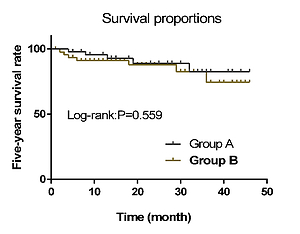Current issue
Archive
Manuscripts accepted
About the Journal
Editorial office
Editorial board
Section Editors
Abstracting and indexing
Subscription
Contact
Ethical standards and procedures
Most read articles
Instructions for authors
Article Processing Charge (APC)
Regulations of paying article processing charge (APC)
HEMATOLOGY / CLINICAL RESEARCH
Comparison of the efficacy of vindesine and leurocristine for pediatric acute lymphoblastic leukemia and their effects on quality of life
1
Department of Hematology, Yinzhou People’s Hospital, Ningbo City,
Zhejiang Province, China
Submission date: 2020-02-25
Final revision date: 2020-06-29
Acceptance date: 2020-07-20
Online publication date: 2021-04-18
Corresponding author
Xiaowei Shi
Department of Hematology, Yinzhou People’s Hospital, No. 251 Baijiang East Road, Ningbo City 315040, Zhejiang Province, China, Tel.: 0574-87017565
Department of Hematology, Yinzhou People’s Hospital, No. 251 Baijiang East Road, Ningbo City 315040, Zhejiang Province, China, Tel.: 0574-87017565
KEYWORDS
TOPICS
ABSTRACT
Introduction:
The present study aimed to compare the efficacy of vindesine with that of leurocristine for pediatric acute lymphoblastic leukemia and their effects on the quality of life.
Material and methods:
We included 94 patients with pediatric acute lymphoblastic leukemia admitted to our hospital for treatment and categorized them into two groups: treatment with vindesine (group A, n = 48) and treatment with leurocristine (group B; n = 48). The effective rate, adverse reactions (thrombocytopenia, anemia, peripheral neurotoxic reaction, infection, nausea, and vomiting) and basic clinical conditions (medical expenses and length of hospital stay) of the patients were observed. In addition, interleukin 6 (IL-6) and tumour necrosis factor-alpha (TNF-α) expression levels were determined by ELISA before and after treatment, posttreatment quality of life score was determined by the Karnofsky Performance Scale (KPS), and the 5-year overall survival was determined in both groups.
Results:
Group A showed no significant difference in the total efficacy rate and 5-year overall survival after treatment (p > 0.05) and had lower medical expenses, length of hospital stay, IL-6 and TNF-α expression, and total incidence of adverse reactions and higher KPS scores than group B (p < 0.05).
Conclusions:
Although no significant difference was observed between vindesine and leurocristine in treating pediatric acute lymphoblastic leukemia, patients administered vindesine had fewer adverse reactions, shorter length of hospital stay, lower medical expenses, and higher quality of life than those administered leurocristine, indicating a potential association with decreased serum IL-6 and TNF-α expression.
The present study aimed to compare the efficacy of vindesine with that of leurocristine for pediatric acute lymphoblastic leukemia and their effects on the quality of life.
Material and methods:
We included 94 patients with pediatric acute lymphoblastic leukemia admitted to our hospital for treatment and categorized them into two groups: treatment with vindesine (group A, n = 48) and treatment with leurocristine (group B; n = 48). The effective rate, adverse reactions (thrombocytopenia, anemia, peripheral neurotoxic reaction, infection, nausea, and vomiting) and basic clinical conditions (medical expenses and length of hospital stay) of the patients were observed. In addition, interleukin 6 (IL-6) and tumour necrosis factor-alpha (TNF-α) expression levels were determined by ELISA before and after treatment, posttreatment quality of life score was determined by the Karnofsky Performance Scale (KPS), and the 5-year overall survival was determined in both groups.
Results:
Group A showed no significant difference in the total efficacy rate and 5-year overall survival after treatment (p > 0.05) and had lower medical expenses, length of hospital stay, IL-6 and TNF-α expression, and total incidence of adverse reactions and higher KPS scores than group B (p < 0.05).
Conclusions:
Although no significant difference was observed between vindesine and leurocristine in treating pediatric acute lymphoblastic leukemia, patients administered vindesine had fewer adverse reactions, shorter length of hospital stay, lower medical expenses, and higher quality of life than those administered leurocristine, indicating a potential association with decreased serum IL-6 and TNF-α expression.
Share
RELATED ARTICLE
We process personal data collected when visiting the website. The function of obtaining information about users and their behavior is carried out by voluntarily entered information in forms and saving cookies in end devices. Data, including cookies, are used to provide services, improve the user experience and to analyze the traffic in accordance with the Privacy policy. Data are also collected and processed by Google Analytics tool (more).
You can change cookies settings in your browser. Restricted use of cookies in the browser configuration may affect some functionalities of the website.
You can change cookies settings in your browser. Restricted use of cookies in the browser configuration may affect some functionalities of the website.



